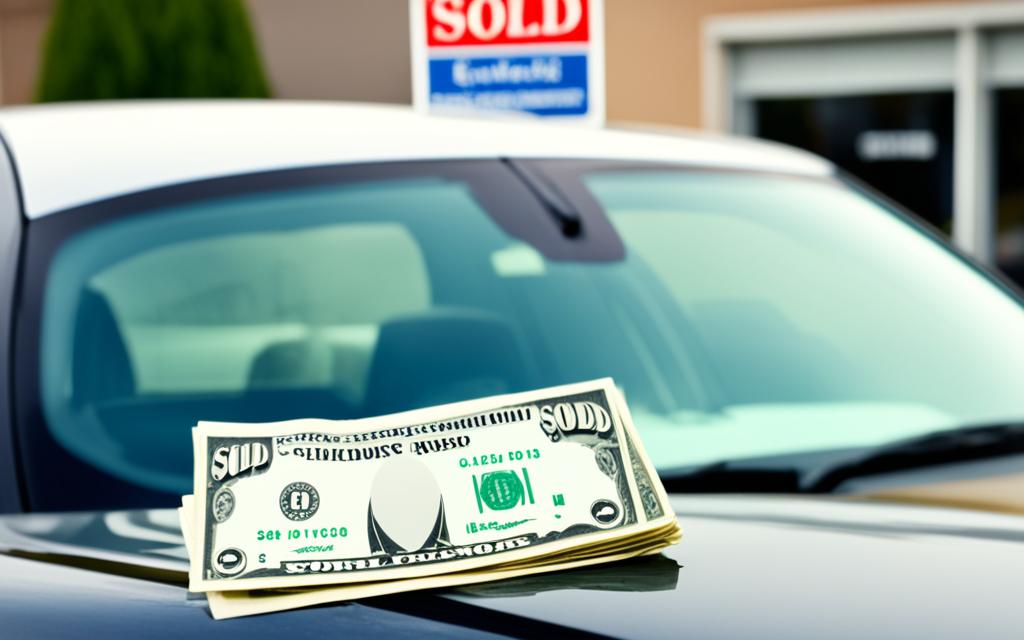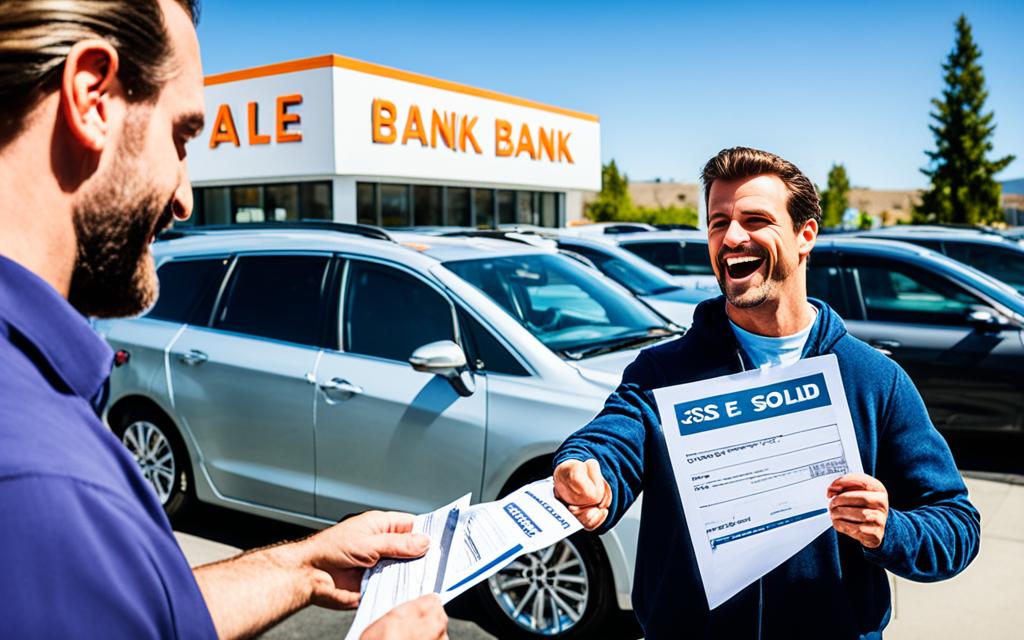Selling a car with a loan can seem like a daunting task, but with the right steps, it can be a smooth and hassle-free process. Whether you’re looking to upgrade to a new vehicle or simply need to sell your current car, it’s important to know how to navigate the situation correctly.
In this comprehensive guide, we will walk you through the necessary steps to successfully sell a car with a loan. From assessing your loan payoff amount to handling the sale transaction, we’ll cover everything you need to know to ensure a successful transaction.
Don’t let the fact that you still have a loan on your car discourage you from selling it. With the proper knowledge and a clear plan of action, you can sell your financed car without any complications.
Key Takeaways:
- Assess the amount needed to pay off your loan before selling the car.
- Thoroughly clean and prepare your car to maximize its value.
- Gather all relevant documentation, including the title and loan payoff information.
- Advertise your car for sale effectively to attract potential buyers.
- Handle the sale transaction carefully, ensuring a smooth transfer of ownership.
Assess Your Loan Payoff Amount
Before selling your car with a loan, it’s essential to determine the amount needed to pay off the loan. This will give you a clear understanding of your financial obligations and help you set the right selling price to cover the loan balance.
To assess your loan payoff amount, follow these steps:
- Contact your lender: Reach out to your lender to obtain a payoff quote. This quote will include the remaining loan balance, any accrued interest, and any applicable fees or penalties. Make sure to ask for the quote in writing for reference.
- Review your loan agreement: Take a close look at your loan agreement to understand if there are any early repayment penalties or specific instructions for selling a financed car. This will help you avoid any surprises during the payoff process.
- Calculate your trade-in value: If you plan to trade in your car, check its current market value. Websites like Kelley Blue Book or Edmunds can provide you with an estimate. Deduct this value from your loan payoff amount to determine if you’ll have any equity to put towards your new vehicle.
- Consider additional costs: Keep in mind any outstanding fees, such as late payment fees or vehicle registration fees, when calculating the loan payoff amount. These fees may need to be settled before transferring ownership to the buyer.
By accurately assessing your loan payoff amount, you’ll be well-informed and prepared for the next steps in selling your car with a loan.
Example: Steps to Assess Your Loan Payoff Amount
- Contact your lender and request a payoff quote.
- Review your loan agreement for any penalties or specific instructions.
- Calculate your car’s trade-in value and deduct it from the loan balance.
- Consider any additional outstanding fees that need to be settled.
“Knowing your loan payoff amount is crucial when selling a car with a loan. It allows you to determine the right selling price and ensures a smooth transaction. Don’t skip this important step!”
Clean and Prepare Your Car for Sale
When selling a car with a loan or financing, presenting a clean and well-maintained vehicle can significantly increase its value and attract potential buyers. Follow these tips to ensure your car is in prime selling condition:
Clean the Exterior
- Wash your car thoroughly, paying special attention to the body, wheels, and windows.
- Wax the exterior to give it a glossy finish and protect the paint.
- Repair any minor dents, scratches, or paint chips.
- Check and replace any burnt-out bulbs in the headlights, taillights, and indicators.
- Ensure your tires are properly inflated and in good condition.
Detail the Interior
- Vacuum the seats, carpets, and floor mats to remove any dirt or debris.
- Clean the dashboard, center console, and door panels with a non-abrasive cleaner.
- Remove any personal belongings from the car.
- Consider shampooing or steaming the upholstery to eliminate any stains or odors.
Address Mechanical Issues
- Make sure all essential components, such as brakes, suspension, and engine, are in good working condition.
- Get a professional inspection to identify and fix any mechanical problems.
- Keep records of recent repairs, maintenance, and service history to reassure potential buyers.
Take High-Quality Photos
Once your car is clean and prepared, take high-quality photos from multiple angles to showcase its best features. Include both exterior and interior shots, highlighting any significant upgrades or unique selling points. These photos will attract potential buyers and increase the likelihood of inquiries and offers.
“A clean car is not only visually appealing, but it also sends a message to buyers that you have taken good care of the vehicle. This can influence their perception of its overall condition and value.”
To showcase the importance of cleaning and preparing your car, let’s take a look at a table comparing the average asking price of clean cars versus dirty cars:
| Condition | Average Asking Price |
|---|---|
| Clean and Well-maintained | $15,000 |
| Dirty and Neglected | $10,000 |
As you can see from the table above, a clean and well-maintained car can command a significantly higher selling price compared to a dirty and neglected one.
In addition to cleaning and preparing your car, there are several other factors to consider when selling a car with a loan or financing. The next section will guide you through gathering all the necessary documentation to ensure a smooth sale.
Gather All Relevant Documentation
When selling a car with a loan, it is crucial to gather all the necessary documentation to ensure a smooth transaction. Having the right paperwork readily available will not only expedite the selling process but also provide potential buyers with the confidence they need.
Here are the essential documents you should gather:
- 1. Title: The car’s title, also known as the “pink slip,” is a legal document that proves ownership. It is crucial to have the title in your possession, as you will need to transfer it to the new owner once the sale is finalized.
- 2. Loan Payoff Information: Contact your lender to obtain the exact amount needed to pay off your loan. This information is essential for calculating the selling price of your car accurately.
- 3. Lien Release Documentation: If there is a lien on your car, you will need to acquire a lien release document from the lender. This document certifies that the loan has been fully repaid, and there are no outstanding obligations on the vehicle.
By ensuring you have these documents ready, you can streamline the selling process and provide potential buyers with the necessary paperwork to complete the transfer of ownership smoothly.
“Having all the relevant documentation in order demonstrates your transparency and can instill confidence in potential buyers.”
| Document | Description |
|---|---|
| Title | The car’s title, also known as the “pink slip,” is a legal document that proves ownership. It needs to be transferred to the new owner. |
| Loan Payoff Information | Contact your lender to obtain the exact amount needed to pay off your loan. This information is essential for determining the selling price of your car. |
| Lien Release Documentation | If there is a lien on your car, you will need to acquire a lien release document from the lender. This document certifies that the loan has been fully repaid, and there are no outstanding obligations on the vehicle. |
Advertise Your Car for Sale
Once you have prepared your car for sale and gathered all the necessary documentation, it’s time to start getting the word out. Effective advertising is key to attracting potential buyers and selling your car with a loan or financing. Here are some tips on where and how to advertise your car:
1. Online Platforms
Utilize popular online platforms such as Craigslist, AutoTrader, and Cars.com to reach a wide audience of car buyers. Create a compelling listing with detailed information about your car, including its make, model, year, mileage, and condition. Be sure to highlight any unique features or recent maintenance that may set your car apart from others on the market. Including high-quality photos can also significantly increase the chances of attracting interested buyers.
2. Social Media
Take advantage of social media platforms such as Facebook Marketplace, Instagram, and Twitter to promote your car sale. Share your listing across your personal network and relevant community groups. Encourage friends and followers to share your post, expanding your reach to potential buyers outside of your immediate circle.
3. Local Classifieds
Don’t overlook the power of traditional local classifieds. Many newspapers and community publications have online classified sections, as well as print listings. Advertise your car in these publications to reach buyers in your local area who may prefer to buy from someone within their community.
Tip: When writing your ads, use attention-grabbing headlines and emphasize the unique selling points of your car. Be honest and transparent about any existing loan or financing on the vehicle to build trust with potential buyers.
Remember to include your contact information in all your advertisements, such as a phone number or email address. Respond promptly to inquiries and be prepared to answer any questions potential buyers may have about the condition, maintenance history, or financing status of your car.
By effectively advertising your car for sale, you can increase visibility and attract serious buyers who are comfortable with purchasing a financed vehicle. The next section will guide you on how to handle the sale transaction and ensure a smooth transfer of ownership.
Responding to Potential Buyers
When selling a car with a loan or a financed car, it’s crucial to communicate effectively with potential buyers. Here are some tips to help you navigate this process:
1. Promptly Respond to Inquiries
When potential buyers reach out with questions or express interest in your car, make sure to respond in a timely manner. Prompt responses show that you’re serious about the sale and can help build trust with potential buyers.
2. Provide Accurate and Detailed Information
Be prepared to answer questions about the car’s condition, maintenance history, mileage, and any other relevant details. By providing accurate and detailed information, you can reassure potential buyers and increase their confidence in the purchase.
3. Negotiate Offers Professionally
When negotiating offers, it’s important to maintain a professional and polite demeanor. Be open to discussing the price and consider any reasonable offers. Remember that the goal is to reach a mutually beneficial agreement.
4. Be Honest About the Loan Status
If the car still has an outstanding loan, be upfront and honest about it. Clearly communicate the existing loan amount and any remaining payments. Honesty can go a long way in building trust with potential buyers.
5. Guide Buyers Through Financing Options
If potential buyers are interested but hesitant due to financing issues, provide them with information about their financing options. For example, they may be able to get a loan to pay off the remaining balance or explore trade-in options.
By following these tips and maintaining transparent communication, you can navigate the process of selling a car with a loan or a financed car successfully.

| Advantages | Challenges |
|---|---|
| Opportunity to sell the car and pay off the loan simultaneously | Potential buyers may be hesitant to purchase a car with an outstanding loan |
| Potential for negotiation to reach a mutually beneficial price | Additional paperwork and coordination required to transfer ownership |
| Flexibility to explore trade-in options | Ensuring that the loan payoff amount is accurate and up-to-date |
Handling the Sale Transaction
Once you have a buyer for your financed car, it’s time to handle the sale transaction. This process involves transferring the title, paying off the loan, and ensuring a smooth transfer of ownership. Follow these steps to complete the sale successfully:
1. Transfer the Title
The first step is to transfer the title of the car to the buyer’s name. Contact your local Department of Motor Vehicles (DMV) or Secretary of State office to understand the specific requirements and procedures for title transfer in your state. Make sure to provide all necessary documents, such as the original title, bill of sale, and any additional forms required by your state.
2. Pay off the Loan
Prior to completing the sale, you must pay off the remaining loan balance on your car. Contact your lender and request a payoff quote, which will include the outstanding loan amount along with any additional fees or charges. Use the funds from the sale of the car to pay off the loan in full.
3. Release the Lien
If there is a lien on your car, you need to obtain a lien release from your lender. This document proves that the loan has been fully satisfied and allows for the transfer of ownership to the buyer. Contact your lender and follow their instructions to obtain the lien release.
4. Transfer Ownership
Once the title has been transferred and the loan has been paid off, you can officially transfer ownership of the car to the buyer. Provide them with the necessary documents, including the signed title, bill of sale, and any other forms required by your state.
5. Ensure a Smooth Transfer
Finally, ensure a smooth transfer of ownership by double-checking that all paperwork is completed accurately and all necessary documents have been provided to the buyer. It’s a good idea to keep copies of all transaction-related documents for your records.
By following these steps, you can successfully complete the sale transaction for your financed car, ensuring a seamless transfer of ownership and a satisfactory completion of your loan obligations.
Paying Off Your Loan
Once you have successfully sold your car with a loan, the next step is to pay off the remaining balance to your lender. This process involves contacting your lender, making the final payment, and obtaining a lien release.
First, reach out to your lender to inform them about the sale of your car and request the exact payoff amount. Make sure to clarify any instructions or specific procedures they may have for paying off the loan.
Once you have the payoff amount, make the final payment to your lender. This can typically be done through various methods such as online banking, wire transfer, or certified check. Ensure that you double-check and accurately enter all payment details to avoid any issues.
After making the final payment, it is crucial to obtain a lien release from your lender. This document confirms that you have paid off the loan in full and allows you to transfer the title to the new owner without any encumbrances. The lien release can be obtained either electronically or through physical documentation, depending on your lender’s process.
Remember, paying off your loan promptly maintains your financial credibility and ensures a smooth transfer of ownership. Keep copies of all relevant documents and communicate with your lender throughout the process to avoid any delays or complications.
“Paying off your loan promptly maintains your financial credibility and ensures a smooth transfer of ownership.”
Now that you have completed the process of paying off your loan, you can proceed with transferring the title and completing the sale transaction. Let’s explore these final steps in the next section.

Trade-In Options for a Car with a Loan
When it comes to selling a car with a loan, one convenient option to consider is trading in your vehicle. Trade-ins allow you to use the remaining loan amount towards the purchase of a new vehicle, simplifying the process and potentially reducing the financial burden.
By opting for a trade-in, you can avoid the hassle of paying off the loan separately and then selling the car. Instead, you can negotiate with the dealership to apply the outstanding loan balance as part of the new vehicle financing.
Trading in your car with a loan amount offers several advantages:
- Simplifies the process: With a trade-in, you can handle both the sale of your current car and the purchase of a new one at the same dealership, streamlining the transaction.
- Convenience: Trading in your car eliminates the need to search for a buyer and go through the entire selling process, saving you time and effort.
- Potential savings: The trade-in amount can be used as a down payment for the new vehicle, reducing the loan amount and potentially lowering your monthly payments.
Before deciding on a trade-in, it’s essential to determine the trade-in value of your vehicle. Research the market value of your car to ensure you are getting a fair deal. Additionally, consider negotiating the trade-in value separately from the purchase of your new car to maximize your benefits.
Trade-In Value vs. Loan Amount
One crucial aspect to keep in mind when trading in a car with a remaining loan amount is the difference between the trade-in value and the loan balance. If the trade-in value exceeds the loan amount, you may have positive equity, which can be used towards the new vehicle or even refunded to you. On the other hand, if the loan amount is higher than the trade-in value, it results in negative equity, which means you’ll need to factor in this outstanding balance when financing your new car.
Consider the following example:
| Trade-In Value | Loan Balance | Equity/Owed |
|---|---|---|
| $10,000 | $12,000 | -$2,000 |
Based on the example above, you can see that the trade-in value is $10,000, while the remaining loan balance is $12,000. This means you have negative equity of $2,000, which you’ll need to account for when financing your new car.
It’s important to note that dealerships may handle negative equity in different ways. Some may roll over the negative equity into your new car loan, while others may offer incentives or promotions to offset the difference. Be sure to discuss these options with your dealer to make an informed decision.
Trading in a car with a loan amount can be a practical option when you’re looking to sell your vehicle. It provides convenience and the potential for financial savings. However, it’s crucial to assess the trade-in value and the loan amount to determine if you have positive or negative equity. By understanding these aspects, you can make an informed decision when trading in your car with a loan.
Dealing with Negative Equity
One of the challenges you may encounter when selling a car with an outstanding loan is negative equity. Negative equity occurs when the amount you owe on the loan is higher than the current value of the car. This can make it difficult to sell the car for enough money to pay off the loan in full.
However, there are strategies you can employ to navigate this situation and minimize the impact of negative equity.
- Pay off the difference: If possible, consider paying off the difference between the loan amount and the car’s value before selling. This will allow you to sell the car without any remaining debt and avoid the complications of negative equity.
- Negotiate with the buyer: When negotiating with potential buyers, be upfront about the negative equity and see if they are willing to take it into account when making an offer. Some buyers may be willing to pay more to help offset the negative equity.
- Trade-in with a reputable dealer: Another option is to trade in your car with a reputable dealer. They may be more experienced in dealing with negative equity and can help you navigate the selling process. Keep in mind that this may not always result in the best financial outcome, as the dealer will likely deduct the negative equity from the trade-in value.
- Consider refinancing or restructuring the loan: If you’re in a position to do so, you could explore refinancing or restructuring your loan to lower the monthly payments and potentially reduce the negative equity. This could provide you with more flexibility when it comes to selling the car.
- Seek professional advice: If you’re unsure about how to handle negative equity when selling a car with a loan, consider seeking advice from a financial advisor or an automotive expert. They can provide personalized guidance based on your specific situation.
Remember, dealing with negative equity requires careful consideration and planning. By exploring these strategies and seeking professional advice, you can navigate the challenge of negative equity and make the best decision when selling your financed car.
Selling a Car with a Lien
When selling a car with a lien, it is essential to address this encumbrance in order to complete a successful transaction. A lien on a vehicle means that there is a legal claim against it, typically due to an outstanding loan or debt. In order to sell the car, you will either need to obtain a lien release from the lender or pay off the lien amount.
Obtaining a lien release is the ideal scenario as it confirms that the debt has been satisfied, allowing for a clean transfer of ownership. To obtain a lien release, you will need to contact your lender and request the necessary paperwork. Once the lien is released, you can proceed with the sale of the car.
If you are unable to obtain a lien release, you will need to pay off the lien amount. This involves contacting the lender to get the exact payoff amount and arranging for the payment. Once the lien is paid off, you will receive documentation confirming the satisfaction of the debt. This documentation can then be provided to the buyer, ensuring a smooth transfer of ownership.
It is important to note that selling a car with a lien may require additional time and effort compared to selling a car without any encumbrances. It is crucial to communicate this information to potential buyers and provide them with the necessary documentation to instill confidence in the transaction.
Tips for Selling a Car with a Lien:
- Be transparent with potential buyers about the lien and the steps you have taken to address it.
- Provide any relevant documentation, such as the lien release or confirmation of paid-off lien, to assure buyers of a clean title transfer.
- Offer flexibility in terms of payment options to accommodate any outstanding lien amount that needs to be settled.
Remember, ensuring a smooth sale when there is a lien on the car requires open communication, transparency, and providing the necessary documentation to the buyer. Taking the time to address the lien properly will help you complete the sale successfully.
| Pros of Selling a Car with a Lien | Cons of Selling a Car with a Lien |
|---|---|
| Offers the opportunity to sell the car quickly without paying off the loan amount upfront | Requires additional steps to address the lien and provide documentation to the buyer |
| Gives potential buyers the option to assume the loan and take over the remaining payments | May limit the pool of potential buyers who are willing to navigate the process of dealing with a lien |
| Allows for the possibility of negotiating a higher sale price to offset the lien amount | Could result in longer closing times and potential complications if the lien is not properly resolved |
Conclusion
Selling a car with a loan may seem like a daunting task, but by following the proper steps, you can ensure a successful and hassle-free transaction. First, assess your loan payoff amount to determine the total you need to pay off before selling the car. Next, clean and prepare your car for sale to enhance its value and attract potential buyers.
Gather all relevant documentation, including the title, loan payoff information, and any lien release documentation. Once you have everything in order, advertise your car for sale using online platforms, social media, and local classifieds. When responding to potential buyers, be communicative and transparent, negotiating offers and answering any questions they may have.
Handle the sale transaction with care, transferring the title and ensuring a smooth transfer of ownership. After the sale, pay off your loan by contacting your lender, making the final payment, and obtaining a lien release if necessary. If you have negative equity, consider strategies for dealing with it when selling the car. Finally, for a car with a lien, obtain a lien release or pay off the lien before completing the sale.
By following these steps, you can sell your car with a loan confidently, knowing that you’ve taken the necessary precautions to protect yourself and ensure a smooth process. Remember, selling a car with a loan is possible and can be a rewarding experience when done right. Good luck!
FAQ
How do I sell a car with a loan?
To sell a car with a loan, follow these steps: 1) Determine your loan payoff amount, 2) Clean and prepare your car for sale, 3) Gather all relevant documentation, 4) Advertise your car for sale, 5) Respond to potential buyers, 6) Handle the sale transaction, 7) Pay off your loan, if necessary.
How do I assess my loan payoff amount when selling a car?
To assess your loan payoff amount, contact your lender and request a payoff quote. This quote will provide you with the exact amount required to pay off your loan in full and obtain the title.
How can I clean and prepare my car for sale?
Cleaning and preparing your car for sale involves washing and waxing the exterior, vacuuming the interior, and addressing any minor repairs or maintenance issues. Additionally, consider getting a professional detailing service to make your car look its best.
What documents do I need when selling a car with a loan?
When selling a car with a loan, you will need the title, loan payoff information from your lender, and any lien release documentation if applicable. It’s important to gather all these documents before proceeding with the sale.
Where and how can I advertise my car for sale?
You can advertise your car for sale through various channels, such as online platforms like Craigslist or Autotrader, social media platforms, and local classifieds. Make sure to provide detailed information and attractive photos to attract potential buyers.
How should I respond to potential buyers when selling a car with a loan?
When communicating with potential buyers, be responsive, provide accurate information about the car, and be open to negotiating the price. Answer any questions they may have and arrange test drives if necessary.
How do I handle the sale transaction when selling a car with a loan?
To handle the sale transaction, ensure that all necessary paperwork is completed, including transferring the title and signing a bill of sale. If there is an outstanding loan, you may need to coordinate with the buyer and your lender to pay off the loan and release the lien.
What should I do to pay off my loan after selling a car?
After selling your car, contact your lender to finalize the loan payoff. Make the final payment as arranged with the lender and obtain a lien release document, which will serve as proof that the loan has been paid in full.
Can I trade in a car with a loan amount still owing?
Yes, you can trade in a car with a loan amount still owing. The trade-in value of your car can be used towards the loan balance, and you can apply the remaining amount towards a new vehicle purchase. However, make sure to negotiate the trade-in value to maximize your benefit.
What should I do if I have negative equity when selling a car with a loan?
If you have negative equity, where the loan balance is higher than the car’s value, you may need to consider paying off the remaining loan balance out of pocket or rolling it into a new loan when purchasing another vehicle. Discuss your options with your lender and consider seeking financial advice.
How do I sell a car with a lien?
Selling a car with a lien can be a bit more complicated. Contact your lender to discuss the process and obtain a lien release. In some cases, you may need to pay off the lien before completing the sale. Ensure that all required paperwork and documentation are in order to transfer the ownership smoothly.








